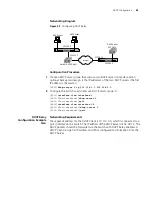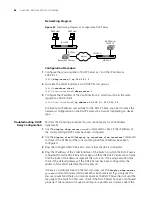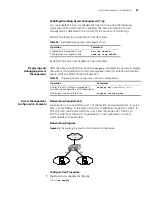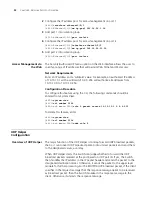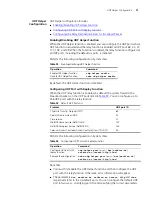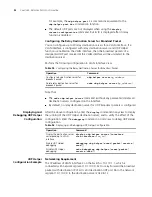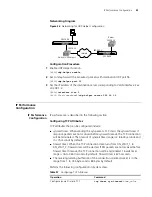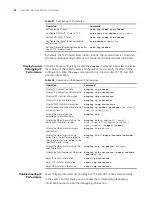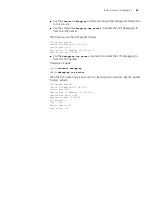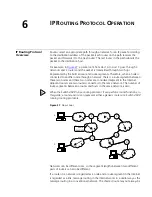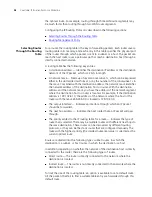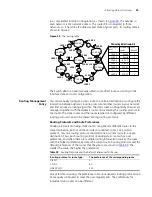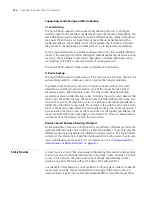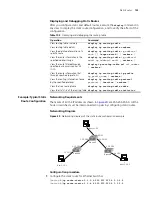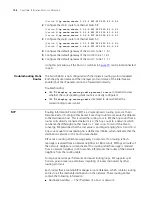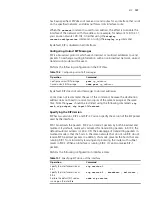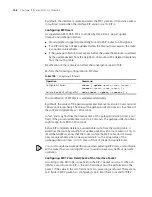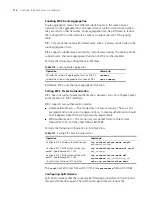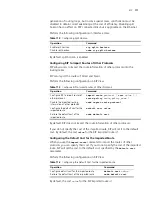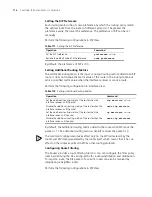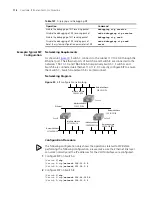
IP Routing Protocol Overview
99
In a complicated Internet configuration, as shown in
Figure 28
, the number in
each network is the network address. The router R8 is connected to three
networks, so it has three IP addresses and three physical ports. Its routing table is
shown in Figure 2.
Figure 28
The routing table
The Switch 4500 can automatically obtain some direct routes according to the
interface state and user configuration.
Routing Management
Policy
You can manually configure a static route to a certain destination or configure the
interaction between dynamic routing protocol and other routers in your network
and find a route via routing algorithm. The static routes configured by the user are
managed together with the dynamic routes discovered by the routing protocol in
the router. The static routes and the routes learned or configured by different
routing protocols can also be shared among routing protocols.
Routing Protocols and Route Preferences
Routing protocols (including static routes) can generate different routes to the
same destination, but not all these routes are optimal. In fact, at a certain
moment, only one routing protocol can determine a current route to a single
destination. Thus, each routing protocol (including static routes) has a set
preference, and when there are multiple routing information sources, the route
with the highest preference becomes the current route. Routing protocols and the
default preferences of the routes that they learn are shown in
Table 99
. The
smaller the value, the higher the preference).
Except for direct routing, the preferences of various dynamic routing protocols can
be manually configured to meet the user requirements. The preferences for
individual static routes can be different.
Forwarding
Port
router
passed
10.0.0.0
Directly
11.0.0.0
12.0.0.0
11.0.0.2
13.0.0.0
3
14.0.0.0
13.0.0.2
3
15.0.0.0
10.0.0.2
2
16.0.0.0
10.0.0.2
2
15.0.0.0
16.0.0.0
10.0.0.0
13.0.0.0
12.0.0.0
14.0.0.0
11.0.0.0
R4
R1
R3
R2
R6
R5
R7
R8
1
11.0.0.2
2
12.0.0.1
12.0.0.2
12.0.0.3
14.0.0.1
14.0.0.2
13.0.0.1
13.0.0.4 11.0.0.1
3
10.0.0.1
10.0.0.2
16.0.0.3
16.0.0.2
15.0.0.2
15.0.0.1
13.0.0.2
16.0.0.2
13.0.0.3
The routing table of router R8
Destination
host
location
Directly
Directly
2
1
1
Forwarding
Port
router
passed
10.0.0.0
Directly
11.0.0.0
12.0.0.0
11.0.0.2
13.0.0.0
3
14.0.0.0
13.0.0.2
3
15.0.0.0
10.0.0.2
2
16.0.0.0
10.0.0.2
2
15.0.0.0
16.0.0.0
10.0.0.0
13.0.0.0
12.0.0.0
14.0.0.0
11.0.0.0
R4
R1
R3
R2
R6
R5
R7
R8
1
11.0.0.2
2
12.0.0.1
12.0.0.2
12.0.0.3
14.0.0.1
14.0.0.2
13.0.0.1
13.0.0.4 11.0.0.1
3
10.0.0.1
10.0.0.2
16.0.0.3
16.0.0.2
15.0.0.2
15.0.0.1
13.0.0.2
16.0.0.2
13.0.0.3
The routing table of router R8
Destination
host
location
Directly
Directly
2
1
1
Table 99
Routing Protocols and the Default Preferences for Routes
Routing protocol or route type
The preference of the corresponding route
DIRECT
0
STATIC
60
UNKNOWN
255
Summary of Contents for 400 Family
Page 12: ......
Page 16: ...14 ABOUT THIS GUIDE ...
Page 58: ...56 CHAPTER 2 PORT OPERATION ...
Page 68: ...66 CHAPTER 3 VLAN OPERATION ...
Page 98: ...96 CHAPTER 5 NETWORK PROTOCOL OPERATION ...
Page 124: ...122 CHAPTER 6 IP ROUTING PROTOCOL OPERATION ...
Page 156: ...154 CHAPTER 8 ACL CONFIGURATION ...
Page 218: ...216 CHAPTER 11 802 1X CONFIGURATION ...
Page 298: ...296 CHAPTER 13 PASSWORD CONTROL CONFIGURATION OPERATIONS ...
Page 336: ...334 APPENDIX B RADIUS SERVER AND RADIUS CLIENT SETUP ...

